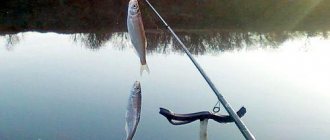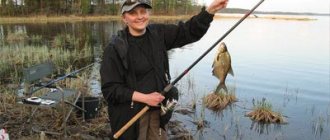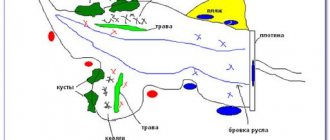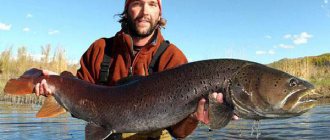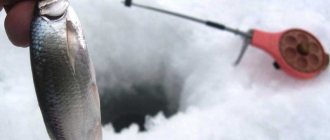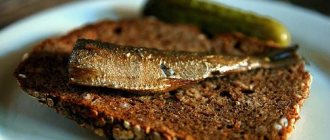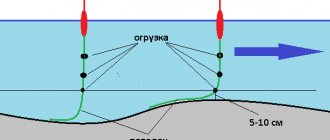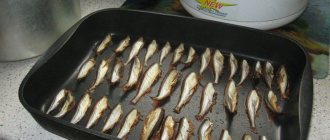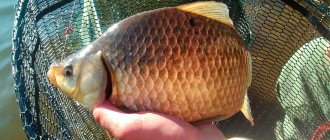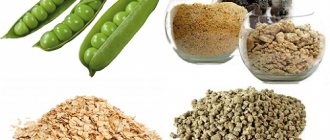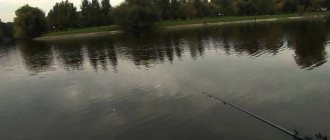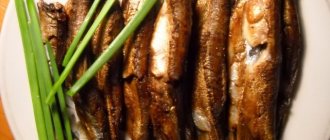Catching bleak on a float rod
Bleak (lat. Alburnus alburnus) is a fish from the carp family (Cyprinidae).
In different regions of Russia, this fish is called differently: in the Vyatka province - “shekleya”, in the Vologda region - “verkhovodka” or even “baskleyka”. Bleak is a small dark grayish fish with a greenish tint, 10-20 cm in size and weighing up to 60 grams, although larger individuals are also found. The bleak's favorite treat is maggots. It is caught using a float rod, which you can make yourself or buy in a specialized store.
Light float rod device
A rod, fishing line, float, sinker, leash and hooks - this is what a float rod with a blind rig consists of.
Rod
The rod should be strong, long, light, elastic and flexible.
The ideal length of a regular fly fishing rod for bleak is 4 m. It is very light and allows you to make casts without wasting any power energy. But when fishing at long ranges, for example, if a large coastal part of your reservoir is covered with grass, choose fishing rods up to 6 meters, but no more, otherwise it will become completely uncomfortable. The material from which the fishing rod is made is carbon fiber, fiberglass or composite. The lightest and most elastic fishing rods are made of carbon fiber (carbon). It is worth remembering only one of their features - you cannot fish with them in a thunderstorm.
Equipment
Equipment is the main component of successful float fishing. Read more about the correct float equipment, and here we will briefly touch on the nuances of the float equipment.
- Fishing line. For catching bleak, we recommend a leash line of up to 0.12 mm, and a main line of 0.16 – 0.18 mm. But a light rig with a thick fishing line cannot be cast far.
- Float. When fishing for bleak, the float should be thin, easily sink into the water when bitten, its upper part should be painted black, yellow, white, pink, or with colored varnish or luminous paint.
- Leash. The leash makes the tackle itself less noticeable for bleaking. The leash is thinner than the main line. When catching bleak, use leashes 0.06-0.08 mm long up to 20 cm.
- Sinkers. When catching bleak, it is advisable to use small pellets strung one after another at a distance of 2-3 mm from each other.
- hooks No. 2.5 according to domestic numbering, so that the bait easily fits into the mouth of a small fish. According to the import classification, hooks No. 16-22 are suitable.
Loading
The float is ideally weighted for catching bleak
The float can be loaded both on the pond and at the time of setting up the equipment at home using a plastic bottle, jar or in the bathtub. The correct loading is at the very beginning of the top of the float. When biting, the fish should not notice strong resistance and the float should quickly sink. Only with such a load is it possible to impart high sensitivity to the entire gear.
Delicious bleak fish
Photo by the author
Bleak lives in many reservoirs with good oxygen conditions. This fish is known to any person who has ever picked up a fishing rod.
Most anglers are dismissive and even negative about catching it, if we mean fish whose size does not exceed 10 cm in length. Another thing is those reservoirs where the average size of a bleak is more than 15 cm. The lively bite of this eternally hungry fish can brighten up the lack of bite of larger fish on a hot summer afternoon. Besides everything else, catching bleak has a purely gastronomic interest. Its fat content reaches 28 percent. Properly cured bleak is not inferior in taste to bream and is far superior to roach.
Now about the best way to catch bleak. Everything said below applies to fishing in still water.
Groundbait Bleak is very responsive to bait, and from the moment the reservoir is opened in the spring, so bait is one of the main conditions for successful fishing. The basis of bleak bait is wheat bran. They are light, poorly wetted by water and float for a long time in its upper layers. Next, it’s good to add oatmeal or roasted and ground oatmeal and coarse breadcrumbs. Powdered milk has proven itself very well. In principle, these components are already enough to create a complete bleak bait. At the reservoir, ballast is added to the bait: coastal sand or loose soil - about a third of the volume. The effectiveness of bait can be significantly increased by adding flavorings to its composition. In spring, this is anise oil, molasses-based artificial honey or banana confectionery essence. In summer – vanilla, cocoa, pear essence, cinnamon. In autumn – raspberry, black currant extracts, apple essence. Flavoring is added to the dry mixture of bait and ballast. Then the bait is mixed with water. It is better to make it liquid, like sour cream, but when casting it is good to use a spoon with an extended handle. The bait should create a stable cloud of turbidity that does not settle for a long time in the water, to which the tackle should be thrown. Tackle High-quality tackle is one of the main conditions for catching bleak. The rod for catching bleak does not need to be long - even on large reservoirs a 5-meter rod is enough, but it should be light, rigid with a soft tip. The shock absorber does not need to be used; it is only required on very hard fishing rods. An overly flexible rod is of little use. The equipment is mounted on a thin fishing line - 0.10-0.12 mm, no thicker. Hook – number 16-18, according to the international classification. Hooks with a long shank are preferable - they are easier to remove from the fish’s mouth and easier to attach some baits to. The weights are distributed evenly along the line, this improves control over the bait when immersing the equipment after casting. When fishing for bleak, two types of sports floats with a carrying capacity of 0.4-1.0 grams are usually used. The first, ratite, is for fishing in the upper layers of water. When fishing at depths greater than 75 cm, it is better to use keel floats with a slightly larger carrying capacity (Fig. 1). Attachments The best attachment for bleaking is maggots (1-2 larvae). At the same time, it is always useful to try to catch maggots of different colors - white, yellow or red. If the bite is bad, sometimes you have to fish with a Chernobyl larva or even with a fly on top. Maggot is good because it stays on the hook for a long time and can withstand up to a dozen bites. Semolina “chatter” with the addition of cinnamon or cocoa is very effective, which takes bleak from spring until freeze-up. The original bait is used when fishing for bleak in early spring in the waters between ice floes and along wide edges - a piece of green cambric 5-7 mm long, tightly set on the shank of the hook. A large bleak takes it from a depth of a meter and a half (Fig. 2). It is possible to use other imitations that correspond to seasonal or local fish food. Fishing technique You should start by choosing a place. In spring and early summer it is a shallow, preferably with a sandy bottom; in summer and autumn it is the border between a shallow and deep water, preferably with hard aquatic vegetation. To control the behavior of fish, it is very good to take polarized glasses when fishing - they allow you to more clearly trace the moment the school approaches and sinks to the depths after the sinking bait. Unlike fishing for roach and bream, the bait is scattered over a fairly wide area - up to 3-4 meters wide. Fishing begins at shallow depths - 30-50 cm, gradually increasing the descent to 1.5 meters. At greater depths there is always a larger bleak, but its bite is more careful. As the bite weakens, add bait in small portions. Ideally, the bait should be fed a little with each cast of the tackle, thereby constantly maintaining a cloud of appetizing turbidity in the fishing zone, which in turn ensures a stable bite. The casting of the rig itself should be done with a snap, with the strongest possible splash, then the rig is slowly pulled through the bait area - the bleak responds perfectly to both the splash and the movement of the feed. For the same purpose, it is advisable to add a little gravel to the bait so that it falls loudly into the water, attracting fish from afar. The fisherman's workplace when fishing for bleak must be carefully organized - the fishing is fast and there is no time to look for something. Light, elegant tackle, a fish tank at hand, tweezers on a suspension, a nozzle on a stand, a towel for wiping hands - all these are indicators of the angler’s skill level.
Anatoly Mailkov August 17, 2012 at 00:00
Lure
The bait should attract fish: taste and smell, due to which it remains in place for a long time.
There are several ways to feed bleak. Let's look at them in order.
- Making splashes of water. You can simply scoop water into your hand and drop it onto the float. Splashes and splashes attract bleak.
- Creating turbidity around the float. Take clay or soil from the shore and leave it to the float. Bleak loves mud, it looks for bait in it. This is where you offer your hook and bait.
- Feeding with surface solid and crumbly food. More on this later.
Recipe for crumbly fine groundbait:
- For bait you will need bran and crackers, preferably bread crumbs.
- Grind them and mix 1:1. It is good to add a flavor with a light fruity smell to the fertilizer: strawberry, pear, vanilla or dill oil.
- Before starting fishing, add a little water to this mixture, mix everything thoroughly, now it is easy to throw it at the fishing point, it will sink very slowly and attract surface bleak.
In cold water, you can add bloodworms to the bait and catch them with it.
A simple crust of bread can act as a purely superficial solid bait. The main thing is not to throw in too large a piece; a piece the size of a chicken egg is enough. The fact is that the fish eat it for a very long time, and if the piece is too large, it will begin to turn sour in the water, which will have a bad effect on the environment.
About how to fish with a bombard - spinning equipment for catching white fish with artificial and animal baits. Catching large bleak at a great distance from the shore.
Tackle for catching bleak
A rod for bleak fishing should be as light as possible, because you will have to swing it a lot. With a heavy rod, your hands will quickly get tired and you will lose the desire to fish. From this we can conclude that a fly rod is best suited.
You should not use long rods; a 3-meter blank will be enough. Bleak rarely moves far from the shore, but even if this happens, it can be lured to the fishing spot by throwing bait or just a handful of sand into the water.
Equipment for catching this fish should be as thin and light as possible. Bleak rarely reaches a size of more than 20 centimeters, so the line can be safely set to 0.1. Using a leash is not necessary, and will even be superfluous, since extra knots will scare away the fish.
float you have. A good bleak float does not exceed 0.5 grams. It is best to use elongated float shapes. Such floats have less resistance when biting, and the fish practically do not feel them.
If you are fishing in windy weather, you can use floats with a drop-shaped body, but they need to be lowered to the middle of the antenna. It is best to load the float with one shot, which will be located directly under the float.
Some fishermen use a backup to quickly submerge the bait; this is justified when bites occur at depth; in other cases, you simply reduce the number of bites. It's better when the bait sinks more naturally.
Remember that loading with one pellet is only relevant for spring ; in summer, such equipment will not work correctly. I will definitely write about summer fishing, so don’t forget to subscribe to the site’s news.
The hooks used are very small. This fish, when it sees a large bait, begins to fiddle with it, trying to bite off a piece, so the bait, and therefore the hook, must be small.
Technique for catching bleak near the surface
To catch bleak, we choose a water area so that there are fewer snags, vegetation and nothing distracts from the fishing process. It is better to choose places under trees; there are definitely large numbers of bleak here, waiting for falling leaves or other living creatures.
We start catching bleak with bait, scattering 2-3 handfuls of it at the intended fishing location, forming a feeding point. This is a circle around the float up to 0.5 m. We scatter the bait with wet hands so that it does not stick to our hands. At the same time, we throw the first portion of bait further away, the rest are getting closer to ourselves. We throw the bait in small portions, creating a cloudy column.
In summer, you need to cast the equipment with a depth of 30-40 cm, no more, but in cold water the fish stays at depth and you need to look for it at half-water or from the bottom. Bites can begin immediately if the bait was at the fishing point. But most often it takes up to 5-15 minutes for the flock to approach the place.
It is necessary to increase the frequency of feeding to form a cloudy column of bait, which slowly settles to the bottom. In this case, the bleak usually grabs the nozzle very actively. If there are no bites, then you need to change the nozzle or fishing depth. It is important to determine the level where the bleak is located.
If there is a forced break in fishing, for example, changing equipment, it is unacceptable to interrupt feeding, otherwise the flock may leave. To do this, you can tie a piece of dry bread with cake bait on a rope, which will float on the surface of the water. This is the bleak's favorite treat.
Principles of bait operation
Bleak most often lives near the surface of the water; the presence of fish can be determined by characteristic sounds. As for the deeper layers, this type of fish almost never sinks to the bottom.
If you plan to fish with bleak, the bait must work on the right layers. If the turbidity from the bait appears too low, the fish simply will not notice it and will not react properly.
Depending on the fishing depth, the prepared mass should have the following consistency:
- if fishing is carried out on the surface, the ball with bait is moistened very slightly. Then it will disintegrate immediately after hitting the water;
- so that the bait disintegrates in the middle layers, it is moistened with a large amount of water;
- if the bait must work at deep levels, it should be sent to the bottom using a special feeder.
Experienced fishermen confirm that bleak almost never drops to a depth of less than 50 cm, and small specimens rise so close to the surface of the reservoir that they can be easily seen.
Do-it-yourself bait for bleaching
Bleak is caught almost all year round. A small, but active and always hungry fish bites confidently, making it interesting to catch.
For a long time it can be difficult sometimes. An accumulation of bleak always arouses the interest of a predator. Therefore, it often happens that the bleak bite suddenly stops.
in spring
Before you start fishing, you should feed the fishing point in advance. It will take from 10 to 15 minutes for your bait to sink to the bottom in the indicated place, and you prepare your gear for fishing. During this time, the fish will have time to calm down after throwing bait balls into the water and will begin to actively gather near the baited spot on the bottom. To prepare the bait you will need the following. We mix branded bait from companies such as Sensas, Milo, Trabucco with regular “Unikorm” in proportions of approximately 1:1. You can also use just one “Unikorm” without adding branded bait, but then the waiting time for the bait to swell will increase slightly. Additionally, we add attractive dye components to our bait - white, red, and yellow. This finely dispersed substance in the water creates a stable and slowly descending cloud of turbidity, which will subsequently attract fish. To make the effect of this dye as effective as possible, it is best to dilute it in warm water in advance. It is worth adding it at the very end, when all the components of the bait are prepared. It is not possible to throw such bait far, but at a distance of 4-5 meters it will be quite sufficient.
Catching bleak on a garland follow the link.
With your own hands
The bait for bleaking is most often various plant mixtures. Sometimes, to keep it in the fishing zone, it is enough to throw a crust of wheat or rye bread onto the surface of the water. When fishing in a current, the crust should be tied with a fishing line to a weight that is lowered to the bottom. A mixture of oatmeal and breadcrumbs is also good - it creates a cloudy, attractive suspension in the water. There are also a number of baits that are used when catching bleak in different layers of water, including from the bottom. Here are their recipes.
Bait made from steamed cake. To 500 g of breadcrumbs add 250 g of sunflower seeds and hemp grains ground in a food processor. 1 teaspoon dry vanilla. 100 g oatmeal. 100 g milk powder. 250 g of clay or river sand. The mixture is moistened with water to form a dough that can be formed into balls the size of an orange.
Millet porridge with steamed cake. Millet porridge is mixed with steamed cake in a 2:1 ratio. roll the balls and deliver them to the feeding area. You can place the bait in gauze so that, when washed out by the current, it creates a cloud of turbidity that attracts fish. Wheat bait, 300 g of wheat grains are ground in a combine and boiled. The resulting mass is mixed with 150 g of ground corn. Add 150 g of steamed cake, 100 g of flour and milk powder, as well as river sand or coastal clay. The rolled balls are lowered into the fishing area.
Fishing technique and tactics
Search for a promising location
Bleak is attracted to:
- boundaries of the main current and calm water in the coastal zone;
- boundaries of direct and reverse flow;
- areas above pits;
- the places where tributaries - streams and small rivers - flow into the body of water where fishing takes place.
Bleak is caught throughout the waters of the reservoir where it lives. A place suitable for fishing should first of all be comfortable, so that you can sit comfortably on the shore, and the vegetation does not interfere with fishing. It is not difficult to lure bleak to the chosen point with bait; this active fish readily approaches the offered treat.
Dependence on the time of year
In summer, bleak stays mainly in the coastal zone. Here she finds a lot of food. In autumn, this fish moves to the depths; good results are obtained by catching it over holes and edges located far from the shore.
In winter, it can be found in any part of the reservoir. Particularly interesting at this time for fishing are the confluences of tributaries, as well as areas where underwater springs emerge at the bottom. The water here is enriched with oxygen, which attracts fish. Catching bleak in the spring, after the ice has melted, can be very successful in shallow waters well warmed by the sun.
Choice of bait
When fishing for bleak, bait is required, as when hunting with a fishing rod for any other white fish. She is not picky about food - almost any food mixture will do. You can use store-bought bait or make it yourself.
To make a mixture for catching bleak with your own hands, mix:
- roasted ground sunflower seeds;
- breadcrumbs;
- boiled millet.
You can add any other fine ingredients to this recipe. A good bleak bait should create a lot of turbidity. To achieve this, you can add milk powder to it. It is the turbidity that hangs in the water that attracts bleak to the fishing point.
Expert opinion
Vladimir Poltoranin
Fisherman - expert
The mixture should be of such a consistency that the balls formed from it disintegrate immediately after hitting the water. Then they will create a fragrant suspension in the water column that will attract fish.
During the current, you can use a feeder filled with bread or cake. Such food will be gradually washed away by the flow of water, and its particles will attract bleak. Another option is to tie a crust of bread to the weight so that it floats at the very surface or slightly below, in the upper layers of the water, and lower this bait with a sinker into the water.
Application of aromatics
The bait mixture will be more attractive for bleak if you add flavorings to it.
In warm water, these fish are attracted to sweet, fruity tastes:
- vanilla;
- honey;
- strawberry;
- tutti-frutti and so on.
In spring, autumn and winter, in cold water, these aromas can scare away fish.
When fishing at this time there are 3 options:
- use sweet flavors in small quantities, from 1/5 to 1/20 of the summer norm;
- use “fishy” flavors – crab, shrimp and the like;
- do without flavorings.
Selection of baits and lures
The bleak feeds on plankton, insect larvae and the insects themselves, worms, eggs, algae and pollen. This omnivorous fish is caught using bait of both plant and animal origin.
To catch it they use:
- maggot;
- bloodworm;
- other insect larvae (for example, burdock);
- worm;
- semolina mash;
- bread.
Maggot is the number 1 bait for catching bleak. This blowfly larva is small in size, making it easy for fish to swallow. Maggot has a hard skin and holds well on the hook, which means you don’t have to change the bait often. The need to constantly change bait when fishing with bloodworms, worms or bread is very tiring, since bleak bites very actively, and you often have to “rotate” when catching it.
The best vegetable bait to use is semolina. It attracts bleak perfectly, and thanks to its high viscosity, it holds well on the hook.
For catching bleak from ice, jigs measuring 2-2.4 mm are suitable. The bait should be small and almost weightless so that the fish can easily pull it into its mouth. Fishing takes place at shallow depths, up to 1-1.5 m, so there is no need to use heavy jigs.
Fishing technique
The bait release depth should be small. Usually this is half a meter or a meter. When fishing far from the shore, you can increase it to 1.5 m. It is at such depths that the bleak bites most actively. These recommendations are relevant for both summer and winter fishing.
Bleak is a very fast and agile fish. Therefore, when catching it, it is important to immediately respond to the bite, hooking and pulling out the trophy that is hooked. This kind of fishing is very dynamic. When the fish approaches the bait, the bites will follow one after another.
Since the bleak is quite small in size, you need to catch many specimens to get a decent catch weight. The count goes into hundreds. Athletes are good at getting one bleak after another at a high pace. But even an amateur can handle this task.
The bleak's lips are quite weak. If you hook it and pull it out of the water too quickly, they tear easily. A fly rod with a very flexible tip or a plug float rod with a shock absorber minimizes this problem. If the rod tip is hard, hook and pull out the fish carefully so as not to lose trophies.
Catching bleak in the current
When fishing for bleak in the current, you can perform short runs with a fly rod or lapdog with a fixed length of equipment, or release the bait 10–15 m or more, releasing the line from the reel. The first option is preferable. Carrying bleak from long distances is problematic.
When catching bleak in the current, you should hold the rig so that it swims slower, and the hook with bait goes ahead of the float. Another option is to let the rig float freely, but periodically stop it briefly. Thanks to the use of these techniques, the number of bites increases.
Fishing in still water
When fishing in still water, the bait, which has dropped to a given depth, can be animated by making light short pulls. This is a good way to revive the interest of bleaks if there are no bites. But, when an active school approaches the bait, the fish usually bites while the rig is being lowered; all that remains is to have time to hook and pull out the fish, so there is no need for additional animation.
You can move all the sinkers, except the sub-weight, higher towards the float so that the bait sinks more slowly. Then the bleak will have a better chance of catching it in the fall.
